| Article ID | Journal | Published Year | Pages | File Type |
|---|---|---|---|---|
| 2533714 | European Journal of Pharmacology | 2010 | 11 Pages |
Membrane rafts and caveolae are specialized microdomains of the cell membrane that form physical platforms for compartmentalization of signalling molecules. Here, we intended to gain insight into the consequences of caveolar localization in G protein-coupled receptor function. We analysed β2-adrenoceptor signalling in purified CRLDF (caveolin-rich low density fractions) of β2-adrenoceptor-overexpressing HEK-293 cells. β2-adrenoceptor and Gs immunoreactivities and forskolin-stimulated adenylate cyclase activity were all detected in CRLDF obtained by the conventional raft purification method that uses Triton X-100 solubilization. However, Triton X-100 caused a complete loss of the functional coupling between β2-adrenoceptor, Gs and adenylate cyclase. Therefore, we developed an optimized purification method based on n-octyl-β-d-glucopyranoside solubilization, where the functional properties of β2-adrenoceptor, Gs and adenylate cyclase were preserved in the CRLDF. Using this method, we showed that isoproterenol-stimulated adenylate cyclase activity was similar in CRLDF and bulk membrane preparations of HEK-293 cells that overexpress β2-adrenoceptor or β2-adrenoceptor–Gs fusion. Accordingly, treatment of cells with methyl-β-cyclodextrin, a caveola-disrupting agent, did not affect β2-adrenoceptor-induced cAMP response. Likewise, these responses were insensitive to caveolin 1 and 2 overexpression. On the other hand, methyl-β-cyclodextrin treatment did decrease β2-adrenoceptor-induced ERK phosphorylation. However, the latter effect of methyl-β-cyclodextrin could be attributed to a non-specific effect rather than its ability to disrupt membrane microdomains. We showed that localization in the raft microdomains did not affect the signalling efficiency of β2-adrenoceptor–Gs–adenylate cyclase pathway, and that methyl-β-cyclodextrin may inhibit signalling by directly affecting the signalling system independently of its caveola-disrupting property.
